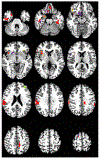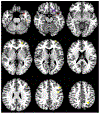Multidimensional imaging techniques for prediction of treatment response in major depressive disorder
- PMID: 30009871
- PMCID: PMC6556149
- DOI: 10.1016/j.pnpbp.2018.07.001
Multidimensional imaging techniques for prediction of treatment response in major depressive disorder
Abstract
A large number of studies have attempted to use neuroimaging tools to aid in treatment prediction models for major depressive disorder (MDD). Most such studies have reported on only one dimension of function and prediction at a time. In this study, we used three different tasks across domains of function (emotion processing, reward anticipation, and cognitive control, plus resting state connectivity completed prior to start of medication to predict treatment response in 13-36 adults with MDD. For each experiment, adults with MDD were prescribed only label duloxetine (all experiments), whereas another subset were prescribed escitalopram. We used a KeyNet (both Task derived masks and Key intrinsic Network derived masks) approach to targeting brain systems in a specific match to tasks. The most robust predictors were (Dichter et al., 2010) positive response to anger and (Gong et al., 2011) negative response to fear within relevant anger and fear TaskNets and Salience and Emotion KeyNet (Langenecker et al., 2018) cognitive control (correct rejections) within Inhibition TaskNet (negative) and Cognitive Control KeyNet (positive). Resting state analyses were most robust for Cognitive control Network (positive) and Salience and Emotion Network (negative). Results differed by whether an -fwhm or -acf (more conservative) adjustment for multiple comparisons was used. Together, these results implicate the importance of future studies with larger sample sizes, multidimensional predictive models, and the importance of using empirically derived masks for search areas.
Copyright © 2018. Published by Elsevier Inc.
Figures






Similar articles
-
Multidimensional prediction of treatment response to antidepressants with cognitive control and functional MRI.Brain. 2017 Feb;140(2):472-486. doi: 10.1093/brain/aww326. Epub 2017 Jan 24. Brain. 2017. PMID: 28122876 Free PMC article.
-
Brain imaging predictors and the international study to predict optimized treatment for depression: study protocol for a randomized controlled trial.Trials. 2013 Jul 18;14:224. doi: 10.1186/1745-6215-14-224. Trials. 2013. PMID: 23866851 Free PMC article. Clinical Trial.
-
Prediction of nonremission to antidepressant therapy using diffusion tensor imaging.J Clin Psychiatry. 2016 Apr;77(4):e436-43. doi: 10.4088/JCP.14m09577. J Clin Psychiatry. 2016. PMID: 27137427 Clinical Trial.
-
Cognitive deficits in bipolar disorders: Implications for emotion.Clin Psychol Rev. 2018 Feb;59:126-136. doi: 10.1016/j.cpr.2017.11.006. Epub 2017 Nov 21. Clin Psychol Rev. 2018. PMID: 29195773 Free PMC article. Review.
-
Functional MRI findings, pharmacological treatment in major depression and clinical response.Prog Neuropsychopharmacol Biol Psychiatry. 2019 Apr 20;91:28-37. doi: 10.1016/j.pnpbp.2018.08.004. Epub 2018 Aug 9. Prog Neuropsychopharmacol Biol Psychiatry. 2019. PMID: 30099082 Review.
Cited by
-
Great Expectations: A Critical Review of and Suggestions for the Study of Reward Processing as a Cause and Predictor of Depression.Biol Psychiatry. 2021 Jan 15;89(2):134-143. doi: 10.1016/j.biopsych.2020.06.012. Epub 2020 Jun 17. Biol Psychiatry. 2021. PMID: 32797941 Free PMC article. Review.
-
AI-assisted prediction of differential response to antidepressant classes using electronic health records.NPJ Digit Med. 2023 Apr 26;6(1):73. doi: 10.1038/s41746-023-00817-8. NPJ Digit Med. 2023. PMID: 37100858 Free PMC article.
-
SSRI Treatment Response Prediction in Depression Based on Brain Activation by Emotional Stimuli.Front Psychiatry. 2020 Nov 13;11:538393. doi: 10.3389/fpsyt.2020.538393. eCollection 2020. Front Psychiatry. 2020. PMID: 33281635 Free PMC article.
-
Negative association between non-suicidal self-injury in adolescents and default mode network activation during the distraction blocks of a rumination task.Suicide Life Threat Behav. 2023 Jun;53(3):510-521. doi: 10.1111/sltb.12960. Epub 2023 Mar 21. Suicide Life Threat Behav. 2023. PMID: 36942887 Free PMC article.
-
Cognitive Control as a 5-HT1A-Based Domain That Is Disrupted in Major Depressive Disorder.Front Psychol. 2019 Mar 29;10:691. doi: 10.3389/fpsyg.2019.00691. eCollection 2019. Front Psychol. 2019. PMID: 30984083 Free PMC article.
References
-
- Gong Q, Wu Q, Scarpazza C, Lui S, Jia Z, Marquand A, Huang X, McGuire P, Mechelli A. Prognostic prediction of therapeutic response in depression using high-field MR imaging. Neuroimage. 2011;55:1497–1503. - PubMed
-
- Borairi S, Dougherty DD. The Use of Neuroimaging to Predict Treatment Response for Neurosurgical Interventions for Treatment-Refractory Major Depression and Obsessive-Compulsive Disorder. Harvard Review of Psychiatry. 2011;19:155–161. - PubMed
Publication types
MeSH terms
Substances
Grants and funding
LinkOut - more resources
Full Text Sources
Other Literature Sources
Medical

